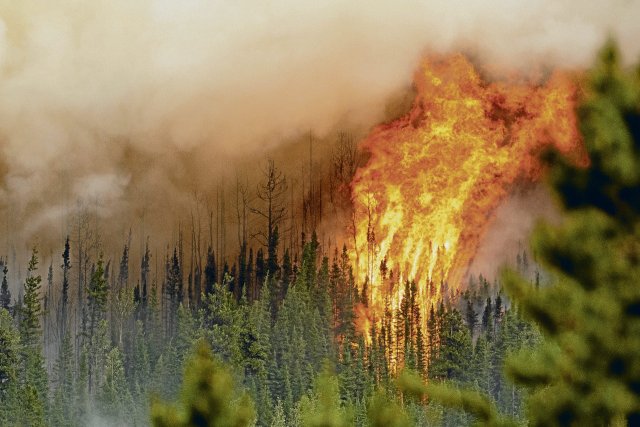Last year the forests burned in Canada, but this year the fires have reached unprecedented proportions.
Photo: dpa/Noah Berger
This year’s wildfire season in Canada has been long and devastating. The first towns were evacuated as early as April, and around a million hectares of forest were in flames by mid-May. A month later it was ten million, more than in any previous season. According to the Canadian Interagency Forest Fire Centre, 6,623 fires were recorded across the country in 2023, covering a total area of around 18 million hectares. For comparison: Last year there were around 1.5 million, and on average it is around 2.5 million hectares. Around 200,000 people were evacuated over the summer, thousands lost their homes and six people lost their lives. Entire villages were destroyed in the flames. The smoke clouds reached the east coast and could still be seen from the US state of Florida in October. Outdoor public events have been canceled for several days in the Canadian provinces of Ontario, Ottawa and Toronto, as well as in the US states of New York, New Jersey and Connecticut. “The word ‘unprecedented’ does not do justice to the magnitude of the wildfires in Canada this year,” says Yan Boulanger, a forest ecology researcher at the Canadian Department of Natural Resources. “From a scientific point of view, the doubling of the previous record burnt area is shocking.”
According to a study by World Weather Attribution, the fires were favored by climate changes. Canada experienced the warmest May-June period since 1940. The humidity was also very low, everything was warmer and drier. And the rain stopped. The fire season has now officially been declared over, but the outlook is poor, according to Canadian government officials. “The drought will continue through the winter in many regions, particularly in the West, and this could have an impact on the timing and intensity of fire activity in spring 2024,” says a recent report.
Forests become CO2-Those
Drought, extreme heat, torrential rain, floods, unpredictable storms and forest fires, all of these consequences of the climate crisis are already a reality in Canada. In addition, the forest fires themselves release enormous amounts of CO2 release, which in turn increases climate change. According to calculations by the EU Earth observation program Copernicus, around 290 megatons of CO were released from the beginning of May to the end of July2 released. This meant that the forests that normally emit CO2 absorb from the atmosphere, from a carbon sink to a carbon dioxide source.
nd.DieWoche – our weekly newsletter

With our weekly newsletter nd.DieWoche look at the most important topics of the week and read them Highlights our Saturday edition on Friday. Get your free subscription here.
“As the risk of wildfires will continue to increase as the climate warms, Canada must reduce fossil fuel consumption and adapt firefighting strategies,” says the government, which wants to make the country climate neutral by 2030. In forest management, among other things, controlled fires and new guidelines for managing forests are being discussed. Canada has around 400 million hectares of forest, which is around 40 percent of the country’s total area. There are still so-called Old Growth, i.e. millennia-old, largely untouched original forests, with centuries-old trees, plant diversity and intact ecosystems. Partially protected, these forests are also repeatedly cut down. And as the climate crisis makes uncontrollable wildfires increasingly likely, the forests themselves are becoming less resilient. Diseases are increasing in some regions, for example drought is causing severe problems for poplars in the forests of Alberta and Saskatchewan. With Canadian forests it is like with European agricultural land: climate change is damaging forestry, but at the same time it is a contributing cause.
The condition of forests can therefore play an important role in the climate crisis. But biodiversity not only cannot be marketed, it is disruptive. When it comes to reforestation, the timber industry relies on conifers; pine is the main plant, followed by spruce and Douglas fir. This creates monocultures with low biodiversity. To do this, it was deemed necessary to remove the “natural early pioneer vegetation – what is called undergrowth and viewed as nothing more than weeds,” said James Steidle of the environmental group Stop the spray BC. Deciduous trees, primarily quaking aspen, but also birch, willow and alder fall into this category. “Wherever they grow in large or small numbers, they are eliminated, either by applying glyphosate from the air or by hand or by manual cutting,” says Steidle. »Ultimately, we have regulations that make fire-resistant trees illegal in our forests. That’s just crazy.”
With glyphosate against unwanted species
After planting, it is important to keep other trees and bushes away so as not to disturb growth. The drug of choice: glyphosate. The Bayer Group’s active ingredient is controversial worldwide, but after years of debate it was recently approved by the EU Commission for another ten years in Europe. In fact, when forestry companies log an area on federal land, they are required to create a “free growing stand” under the Forest and Range Practices Act. The law defines a free-growing stand as “a stand of healthy trees of a commercially valuable species, the growth of which is not hindered by competition from plants, shrubs or other trees.” In the province of British Columbia alone, around 17,000 hectares of forested areas are sprayed with herbicides every year, primarily with glyphosate-based herbicides.
The product is not only effective against unwanted trees in the short term. A study published in 2021 by Lisa Wood, a plant biologist at the University of Northern British Columbia, found that glyphosate remains in the tissues of forest plants for over a decade after application. The herbicide affects the plants’ ability to grow and bear fruit. “The viability of pollen from treated plants is reduced by an average of 66 percent,” she writes. “Reduced pollination leads to lower fruit production and thus a reduction in plant populations and food for animals that depend on them.”
In addition, biodiversity in the forests is important in the Canadian culture of the First Nations. However, the Canadian government’s BC Timber Sales Plan aims to eradicate plants such as salmonberry, blueberry, foxglove, elderberry, blueberry, fireweed and mushrooms in the logging areas. Viewed as “pests” in forestry terms, these plants are important to the First Nations, explains Hopkins Rose, a member of the St’át’imc Nation, to the Canadian online magazine The Tyee: “These are all culturally significant plants and medicines that are used by have been harvested and relied upon by local indigenous peoples for thousands of years.”
The increasing number of monoculture forests are less resilient, they burn more easily than mixed forests and are losing their climate function. Steidle from “Stop the Spray BC” criticizes: “Nevertheless, across Canada we view deciduous forests as weeds. We have strict laws that require reforestation with conifers. This is ‘sustainable yield management’ and the core of our claim that our forests are managed sustainably.”
Become a member of the nd.Genossenschaft!
Since January 1, 2022, the »nd« will be published as an independent left-wing newspaper owned by the staff and readers. Be there and support media diversity and visible left-wing positions as a cooperative member. Fill out the membership form now.
More information on www.dasnd.de/genossenschaft
